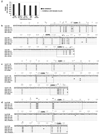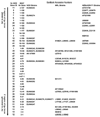Vkappa polymorphisms in NOD mice are spread throughout the entire immunoglobulin kappa locus and are shared by other autoimmune strains
- PMID: 20556377
- PMCID: PMC2970566
- DOI: 10.1007/s00251-010-0457-9
Vkappa polymorphisms in NOD mice are spread throughout the entire immunoglobulin kappa locus and are shared by other autoimmune strains
Abstract
The diversity of immunoglobulin (Ig) and T cell receptor (TCR) genes available to form the lymphocyte repertoire has the capacity to produce a broad array of both protective and harmful specificities. In type 1 diabetes (T1D), the presence of antibodies to insulin and other islet antigens predicts disease development in both mice and humans, and demonstrate that immune tolerance is lost early in the disease process. Anti-insulin T cells isolated from T1D-prone non-obese diabetic (NOD) mice use polymorphic TCRalpha chains, suggesting that the available T cell repertoire is altered in these autoimmune mice. To probe whether insulin-binding B cells also possess polymorphic V genes, Ig light chains were isolated and sequenced from NOD mice that harbor an Ig heavy chain transgene. Three insulin-binding Vkappa genes were identified, all of which were polymorphic to the closest germline sequence matches present in the GenBank database. Additional analysis of over 300 light chain sequences from multiple sources, including germline DNA, shows that polymorphisms are spread throughout the entire NOD Igkappa locus, as these polymorphic sequences represent 43 distinct Vkappa genes which belong to 14 Vkappa families. Database searches reveal that a majority of polymorphic Vkappa genes identified in NOD are identical to Vkappa genes isolated from SLE-prone NZBxNZW F1 or MRL strains of mice, suggesting that a shared Igkappa haplotype may be present. Predicted amino acid changes preferentially occur in CDR, and thus could alter antigen recognition by the germline B cell repertoire of autoimmune versus non-autoimmune mouse strains.
Figures





Similar articles
-
Multiple germline kappa light chains generate anti-insulin B cells in nonobese diabetic mice.J Immunol. 2005 Jul 15;175(2):1073-9. doi: 10.4049/jimmunol.175.2.1073. J Immunol. 2005. PMID: 16002708
-
Somatic mutations in the Ig variable region genes and expression of novel Cmu-germline transcripts in a B-lymphoma cell line ("Farage") not producing Ig polypeptide chains.Leuk Lymphoma. 1998 Aug;30(5-6):637-49. doi: 10.3109/10428199809057576. Leuk Lymphoma. 1998. PMID: 9711926
-
The natural autoantibody repertoire of nonobese diabetic mice is highly active.J Immunol. 2002 Dec 1;169(11):6617-24. doi: 10.4049/jimmunol.169.11.6617. J Immunol. 2002. PMID: 12444175
-
Dynamic Control of Long-Range Genomic Interactions at the Immunoglobulin κ Light-Chain Locus.Adv Immunol. 2015;128:183-271. doi: 10.1016/bs.ai.2015.07.004. Epub 2015 Aug 14. Adv Immunol. 2015. PMID: 26477368 Review.
-
Transcription factories in Igκ allelic choice and diversity.Adv Immunol. 2019;141:33-49. doi: 10.1016/bs.ai.2018.11.001. Epub 2018 Dec 19. Adv Immunol. 2019. PMID: 30904132 Free PMC article. Review.
Cited by
-
Regulation of basement membrane-reactive B cells in BXSB, (NZBxNZW)F1, NZB, and MRL/lpr lupus mice.Autoimmunity. 2013 May;46(3):188-204. doi: 10.3109/08916934.2012.746671. Epub 2013 Jan 9. Autoimmunity. 2013. PMID: 23157336 Free PMC article.
-
New Players in the Field of T1D: Anti-Peripherin B Lymphocytes.Diabetes. 2016 Jul;65(7):1794-6. doi: 10.2337/dbi16-0017. Diabetes. 2016. PMID: 27329956 Free PMC article. No abstract available.
-
B lymphocyte "original sin" in the bone marrow enhances islet autoreactivity in type 1 diabetes-prone nonobese diabetic mice.J Immunol. 2013 Jun 15;190(12):5992-6003. doi: 10.4049/jimmunol.1201359. Epub 2013 May 15. J Immunol. 2013. PMID: 23677466 Free PMC article.
-
Immunoglobulin genes, reproductive isolation and vertebrate speciation.Immunol Cell Biol. 2022 Aug;100(7):497-506. doi: 10.1111/imcb.12567. Epub 2022 Jul 4. Immunol Cell Biol. 2022. PMID: 35781330 Free PMC article.
-
Characterization of extensive diversity in immunoglobulin light chain variable germline genes across biomedically important mouse strains.Immunohorizons. 2025 Jul 14;9(8):vlaf031. doi: 10.1093/immhor/vlaf031. Immunohorizons. 2025. PMID: 40682361 Free PMC article.
References
-
- Atkinson MJ, Cowan MJ, Feeney AJ. New alleles of IGKV genes A2 and A18 suggest significant human IGKV locus polymorphism. Immunogenetics. 1996;44:115–120. - PubMed
-
- Carrillo J, Puertas MC, Planas R, Pastor X, Alba A, Stratmann T, Pujol-Borrell R, Ampudia RM, Vives-Pi M, Verdaguer J. Anti-peripherin B lymphocytes are positively selected during diabetogenesis. Mol Immunol. 2008;45:3152–3162. - PubMed
-
- Hulbert C, Riseili B, Rojas M, Thomas JW. B cell specificity contributes to the outcome of diabetes in nonobese diabetic mice. J Immunol. 2001;167:5535–5538. - PubMed
-
- Janeway CA, Jr, Travers P, Walport M, Shlomchik M. Immunobiology: the immune system in health and disease. New York, NY: Garland; 2001.
Publication types
MeSH terms
Substances
Grants and funding
- R01 DK084246/DK/NIDDK NIH HHS/United States
- HL65962/HL/NHLBI NIH HHS/United States
- P30 DK058404/DK/NIDDK NIH HHS/United States
- U01 HL065962/HL/NHLBI NIH HHS/United States
- 5 T32 HL069765/HL/NHLBI NIH HHS/United States
- T32 HL069765/HL/NHLBI NIH HHS/United States
- 5 T32 GM08554/GM/NIGMS NIH HHS/United States
- L40 AI057271/AI/NIAID NIH HHS/United States
- CA68485/CA/NCI NIH HHS/United States
- DK058404/DK/NIDDK NIH HHS/United States
- P30 CA68485/CA/NCI NIH HHS/United States
- U19 HL065962/HL/NHLBI NIH HHS/United States
- R01 AI051448/AI/NIAID NIH HHS/United States
- P30 DK020593/DK/NIDDK NIH HHS/United States
- P30 CA068485/CA/NCI NIH HHS/United States
- T32 GM008554/GM/NIGMS NIH HHS/United States
- R21 AI051448/AI/NIAID NIH HHS/United States
- AI051448/AI/NIAID NIH HHS/United States
- DK20593/DK/NIDDK NIH HHS/United States
- K08 DK070924/DK/NIDDK NIH HHS/United States
LinkOut - more resources
Full Text Sources

